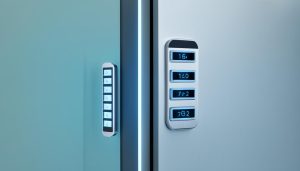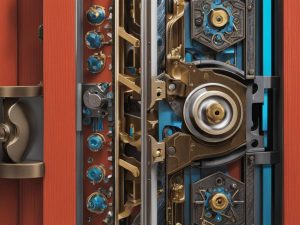Enhance the accessibility and security of your home with smart locks. With the convenience of smartphone control and remote access, smart locks offer peace of mind and ease-of-use. But with different types of smart locks available, it’s important to know how to choose the right one for your home.
When choosing a smart lock, consider factors like compatibility, security features, and ease of installation. Retrofit options allow you to keep your existing deadbolt and provide convenience for renters or those who prefer to keep their physical keys. Complete deadbolt replacement provides more options and features, but may require more effort to install.
Communication protocols like Bluetooth, Z-Wave, and Wi-Fi need to be considered to ensure seamless connectivity with your smartphone and other smart home devices. Integration with third-party products, such as popular smart home platforms and voice assistants, can enhance the functionality and security of your home.
Decide how you want to interact with your lock, whether it’s through a smartphone app or keyless entry options like fingerprint scanning or touchpad codes. Explore the emerging trend of in-home delivery, which allows authorized personnel to securely access your home for package drop-offs.
While smart locks offer convenience, they should be part of a comprehensive home security system. Evaluate your home security needs and combine smart locks with other measures like reinforcement, security cameras, and alarm systems.
As the smart lock market grows, stay informed about the latest developments and advancements to make informed purchasing decisions. Choosing and installing the right smart lock for your home requires careful consideration.
Key Takeaways:
- Consider compatibility, security features, and ease of installation when choosing a smart lock.
- Retrofit options allow you to keep your existing deadbolt, while complete deadbolt replacement offers more features but requires more effort to install.
- Bluetooth, Z-Wave, and Wi-Fi are common communication protocols for smart locks.
- Integrate your smart lock with other third-party devices for enhanced functionality and security.
- Choose a smart lock that offers your preferred method of interaction, such as a smartphone app or keyless entry options.
Should You Keep or Replace Your Existing Deadbolt?
When considering the installation of a smart lock, one important decision to make is whether to keep or replace your existing deadbolt. There are two options available: retrofit smart locks and complete deadbolt replacement.
Retrofit Smart Locks
Retaining your existing deadbolt is made possible with retrofit smart locks. These innovative locks can be installed over your current deadbolt hardware, allowing you to keep using your physical keys. This option is particularly convenient for renters or homeowners who prefer not to change their keys. Retrofit smart locks, such as the August Wi-Fi Smart Lock and Kwikset Kevo Convert, are designed to be compatible with a wide range of standard deadbolt brands.
“Keep your existing deadbolt and enjoy the convenience of a smart lock with retrofit options.”
Complete Deadbolt Replacement
On the other hand, some smart locks require the complete replacement of your existing deadbolt. This option provides more features and customization possibilities but may require additional time and effort for installation. Smart locks like the Schlage Sense Bluetooth Deadbolt and Yale Assure SL Touchscreen Deadbolt fall into this category.
“Upgrade to a brand-new smart lock with complete deadbolt replacement and unlock advanced features.”
Choosing whether to keep or replace your existing deadbolt depends on your preferences, needs, and circumstances. For those who prefer a hassle-free installation process and want to keep their physical keys, retrofit smart locks offer a convenient solution. On the other hand, homeowners who are willing to undergo a more involved installation process and desire a wider range of features may opt for complete deadbolt replacement options.
Weighing the benefits and considerations of each option will help you make an informed decision that aligns with your specific needs and preferences.
Picking a Protocol: Bluetooth, Z-Wave, or Wi-Fi
Smart locks are designed to communicate with your smartphone and other smart home devices, enabling you to control and monitor your locks remotely. To establish this seamless communication, smart locks utilize different communication protocols. The three most common protocols used in smart locks are Bluetooth, Z-Wave, and Wi-Fi.
Bluetooth:
Bluetooth is a short-range wireless protocol that offers a direct connection between your smartphone and the smart lock. This protocol is known for its low power consumption, resulting in longer battery life for your smart lock. With Bluetooth, you can lock or unlock your door using your smartphone when you’re in close proximity to the lock. It provides a convenient and reliable connection without the need for a separate hub or Wi-Fi connection.
Z-Wave:
Z-Wave is a wireless communication protocol that requires a compatible hub to connect your smart lock to your home network. Unlike Bluetooth, Z-Wave allows you to control and monitor your smart lock from anywhere, as long as there is an internet connection. The advantage of Z-Wave is its ability to connect with a wide range of smart home devices, creating a unified smart home ecosystem. However, keep in mind that Z-Wave-enabled smart locks may require an additional hub, which adds to the overall setup cost.
Wi-Fi:
Wi-Fi-enabled smart locks provide the most versatility and integration options. With a Wi-Fi connection, you can control and monitor your lock remotely from anywhere with an internet connection. Wi-Fi-enabled smart locks often offer advanced features such as voice control through integration with voice assistants like Google Assistant and Amazon Alexa. Additionally, Wi-Fi-enabled smart locks can be easily incorporated into your existing smart home setup, allowing seamless integration with other compatible devices. However, it’s important to note that Wi-Fi-enabled smart locks typically require a constant power source and may have higher power consumption compared to Bluetooth or Z-Wave locks.
When choosing a smart lock protocol, consider your specific needs and your existing smart home setup. Bluetooth locks are ideal if you prioritize longer battery life, simplicity, and direct smartphone connectivity. Z-Wave locks are suitable if you want to create a comprehensive smart home system with multiple connected devices. Wi-Fi locks offer the widest range of features and integration options, making them perfect for those who seek maximum flexibility and control.
It’s worth noting that some smart locks may support multiple protocols, providing you with the flexibility to choose the most suitable communication method for your needs. Before making a decision, ensure that your chosen protocol is compatible with your smartphone, hub (if applicable), and other smart home devices.
Connecting to Third-Party Products
Smart locks offer the convenience of integrating with other third-party smart home products, enhancing the functionality and security of your home. Many renowned smart lock brands, such as August and Schlage, support seamless integration with popular smart home platforms like Amazon Alexa, Google Assistant, and IFTTT. This compatibility allows you to control your smart lock using voice commands and automate tasks in conjunction with other connected devices. Before making a decision, it is crucial to check the compatibility of a smart lock with your existing smart home ecosystem to ensure a smooth and efficient integration.
| Supported Third-Party | Smart Home Platforms |
|---|---|
| August | Amazon Alexa, Google Assistant, IFTTT |
| Schlage | Amazon Alexa, Google Assistant, IFTTT |
August Smart Lock Pro
Connectivity: Wi-Fi, Bluetooth
Integration: Amazon Alexa, Google Assistant, IFTTT
The August Smart Lock Pro offers a wide range of third-party integrations, providing you with the flexibility to incorporate it into your existing smart home ecosystem. With support for Amazon Alexa, Google Assistant, and IFTTT, you can effortlessly control your smart lock using voice commands or create automated routines that sync with other smart devices.
Schlage Encode Smart WiFi Deadbolt
Connectivity: Wi-Fi
Integration: Amazon Alexa, Google Assistant, IFTTT
The Schlage Encode Smart WiFi Deadbolt seamlessly integrates with various smart home platforms, allowing you to enhance the security and functionality of your home. By connecting to Amazon Alexa, Google Assistant, and IFTTT, you can control the lock with voice commands, create custom automations, and enjoy a more connected and convenient smart home experience.
How Do You Want to Interact with Your Lock?
Smart locks offer different ways to interact with them. Most smart locks come with a smartphone app that allows you to lock and unlock the door remotely, assign unique access codes, and monitor activity logs. Some advanced smart locks also support keyless entry options, such as fingerprint scanning or touchpad codes. It’s important to consider how you prefer to interact with your lock and choose a smart lock that offers the features and functionality that align with your preferences.
Interacting with your smart lock through a smartphone app provides unparalleled convenience and control. With just a few taps on your phone, you can lock or unlock your door from anywhere. You can even grant temporary access to visitors, contractors, or Airbnb guests by assigning unique access codes. This eliminates the need for physical keys and gives you the ability to monitor who enters and exits your home through detailed activity logs.
For those looking for a keyless entry option, some smart locks offer advanced features like fingerprint scanning or touchpad codes. With fingerprint scanning, you can simply place your finger on the lock to unlock it, providing a seamless and secure entry method. Touchpad codes allow you to enter a unique code on a touchscreen keypad to unlock the door, eliminating the need for physical keys or a smartphone.
“The smartphone app for my smart lock has been a game-changer. I no longer have to worry about forgetting to lock the door when I leave or rushing home to let someone in. I can control access to my home with ease, which gives me peace of mind.” – Emily, satisfied smart lock user
When choosing a smart lock, consider how you want to interact with it on a daily basis. If you prefer the convenience of a smartphone app and the ability to manage access remotely, a lock with a dedicated app is the way to go. If you prefer a keyless entry option for easy and secure access, look for a smart lock that supports fingerprint scanning or touchpad codes.
Comparison of Smart Lock Interaction Methods
| Interaction Method | Features |
|---|---|
| Smartphone App |
|
| Fingerprint Scanning |
|
| Touchpad Codes |
|
In-home Delivery Is Happening
One of the emerging trends in smart locks is in-home delivery, which allows authorized delivery personnel to securely access your home and drop off packages inside. Services like Amazon Key and Walmart InHome Delivery utilize smart locks to provide this convenient and secure delivery option. While in-home delivery offers convenience and eliminates the risk of porch theft, it’s essential to carefully evaluate the security measures and protocols offered by the service provider before opting for this feature.
When considering in-home delivery, it’s crucial to prioritize security and convenience. Understand the safety measures and precautions implemented by the delivery service, ensuring that only authorized individuals have access to your home. Evaluate the protocols used to authenticate and monitor delivery personnel to maintain the integrity of your home security.
Benefits of In-home Delivery
- Convenience: Having packages delivered directly inside your home saves you time and eliminates the need to coordinate delivery schedules or worry about missed deliveries.
- Security: In-home delivery reduces the risk of package theft, ensuring that your valuable purchases are safely placed indoors.
- Weather Protection: By bypassing outdoor delivery, in-home delivery protects your packages from adverse weather conditions like rain or snow.
- Peace of Mind: Being able to monitor the delivery process through smart lock integration provides peace of mind and transparency.
Before opting for in-home delivery, consider these factors:
- Compatibility: Ensure that your current smart lock is compatible with the in-home delivery service you wish to use.
- Service Availability: Check if in-home delivery is available in your area.
- Terms and Conditions: Familiarize yourself with the terms and conditions of the in-home delivery service and understand the level of control you have over the delivery process.
- Alternative Options: Evaluate other secure delivery options offered by the service provider, such as lockboxes or designated delivery areas.
By carefully evaluating the security measures, weighing the benefits, and considering the compatibility with your smart lock, you can determine if in-home delivery is the right choice for your needs.
If you have any further questions about in-home delivery or need assistance with your smart lock, you can reach our customer support team at 1-844-228-4012.
| Pros | Cons |
|---|---|
| Convenience of packages being delivered inside your home | Requires careful evaluation of security measures and protocols |
| Reduces the risk of porch theft | Compatibility with existing smart locks |
| Protection from adverse weather conditions | Availability of in-home delivery service in your area |
| Ability to monitor the delivery process through smart lock integration | Understanding the terms and conditions of the service |
Enhancing Home Security
While smart locks offer convenience and accessibility, it’s important to note that they are not a standalone security solution. Smart locks provide additional control and efficiency in locking and unlocking your door, as well as the ability to extend digital keys to authorized individuals. However, the overall security of your home relies on a combination of factors, such as door and window reinforcement, security cameras, and alarm systems. It’s important to assess your home security needs and consider how smart locks can complement your existing security measures.
The Future of Smart Locks
The smart lock market is poised for substantial growth in the coming years as more Canadian homeowners embrace the convenience and security of connected home technology. Advancements in biometric authentication, voice recognition, and integration with other smart devices are propelling the evolution of smart locks, making them increasingly feature-rich.
Looking ahead, future trends in the smart lock market will likely include:
- Increased compatibility with smart home ecosystems: Smart locks will offer seamless integration with a wide range of smart devices and platforms, allowing homeowners to control their locks alongside other connected devices in their homes.
- Improved battery life: Manufacturers will invest in research and development to enhance the battery life of smart locks, reducing the need for frequent battery replacements and ensuring continuous functionality.
- Seamless integration with voice assistants: Smart locks will become even more intuitive and user-friendly by integrating with popular voice assistant platforms like Google Assistant and Amazon Alexa, enabling homeowners to lock and unlock their doors using voice commands.
This is an exciting time in the world of smart locks, as technological advancements continue to enhance the security and convenience they offer. Staying informed about the latest developments in the smart lock market will empower Canadian homeowners to make informed purchasing decisions and take full advantage of the benefits that connected home technology has to offer.
Conclusion
Choosing and installing the right smart lock for your home is a decision that requires careful consideration. By evaluating factors like compatibility, communication protocols, integration with third-party devices, and security features, you can select a smart lock that fits your specific needs.
While smart locks offer convenience and enhanced control, it’s important to remember that they are just one part of a comprehensive home security system. By combining smart locks with other security measures, such as reinforced doors and windows, security cameras, and alarm systems, you can create a secure and efficient home environment.
Stay informed about the latest advancements in smart lock technology to make the most informed decision for your home. With the rapid evolution of connected home technology, smart locks are constantly improving with features like biometric authentication and voice recognition. Being aware of these advancements can help you choose a smart lock that offers enhanced security and convenience.
FAQ
What are smart locks?
Smart locks are electronic locks that provide enhanced accessibility and security for your home. They allow you to lock and unlock your doors remotely using a smartphone.
What types of smart locks are available?
There are different types of smart locks available, including Bluetooth locks and biometric locks. Bluetooth locks use a direct connection to your phone, while biometric locks use fingerprint scanning or other forms of personal identification.
Can I keep my existing deadbolt with a smart lock?
Yes, there are retrofit smart locks available that can be installed over your existing deadbolt, allowing you to keep your physical keys. This is convenient for renters or those who do not wish to change their keys.
What communication protocols do smart locks use?
The most common communication protocols for smart locks are Bluetooth, Z-Wave, and Wi-Fi. Bluetooth offers longer battery life and direct connection with your phone, while Z-Wave requires a compatible hub, and Wi-Fi provides more options for features and integration.
Can smart locks integrate with other smart home devices?
Yes, many smart locks support integration with popular smart home platforms like Amazon Alexa, Google Assistant, and IFTTT. This allows you to control your smart lock using voice commands and automate tasks with other connected devices.
How can I interact with my smart lock?
Most smart locks come with a smartphone app that allows you to lock/unlock the door remotely, assign access codes, and monitor activity logs. Some advanced smart locks also support keyless entry options like fingerprint scanning or touchpad codes.
What is in-home delivery, and can I use it with a smart lock?
In-home delivery is a service that allows authorized delivery personnel to securely access your home and drop off packages inside. Some smart locks, like those supported by Amazon Key and Walmart InHome Delivery, integrate with these services to provide this convenient option.
Can smart locks replace other home security measures?
While smart locks provide additional control and convenience, they are not a standalone security solution. They should be used in conjunction with other measures like door and window reinforcement, security cameras, and alarm systems to ensure comprehensive home security.
What is the future of smart locks?
The smart lock market is predicted to grow significantly in the coming years. Future trends may include increased compatibility with smart home ecosystems, improved battery life, and seamless integration with voice assistants like Alexa and Google Assistant.
How do I choose the right smart lock for my home?
To choose the right smart lock, consider factors like compatibility with your existing setup, communication protocols, integration with third-party devices, and the specific features and functionality that align with your preferences.





